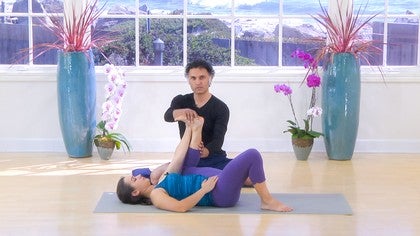Description
About This Video
Transcript
Read Full Transcript
So, as a teacher, I think one of the most important skills is to be able to observe your students and to respond to what you observe. But one of the first things with observation is just to look at what is. Not immediately say, oh, I see this imbalance, so I'll fix it this way. I see this, because I find if we go with what we first see, there's so many details that we miss, and it's this simple act of observing, taking our time, stepping back, and receiving in a way what the student is giving us, rather than us making up our minds what needs to be fixed. So, we've spent a lot of time in these classes looking at breath.
Shavasana can be looked at as one of the great poses to understand your breath, and in this supported format, raising knees a bit, allowing the head of the thigh bones to drop, using the sandbag to encourage that whole welcoming of the breath into the lower body. You can set your student up in a pose like this, and then see what happens over time. See how the body changes, because we know it from our own practice. When we put ourselves in a restorative pose, for example, over time, we feel a little opening here, a change here, our breath moving into areas of our body that it may not normally go to. So, see if you can notice that in your students when you're working with them.
And especially, you can look at their belly, see how it's moving. It's often an imbalance one side to the other, so which side has the sense of more freedom, which side may be a bit constricted. And we know from talking with Junha over these past few classes, it's a little bit more congestion in her left hip. And you can, in fact, see this left hip is a little bit higher, so you could come and put a bit more pressure on this hip. How does that feel in your body if I put more pressure on this one side?
It feels relieving, like the tension in the hip has been able to release. And I can see now this side of her belly settles a little bit more on the exhalation. So looking and asking the student questions, responding, and also knowing everything is not going to work for every student. I like using the sand, the eye pillow as a little tactile aid, but earlier when we put it on Junha's collarbones, she said it didn't really work for her. So it's your responsibility to listen to that and notice that, not say, OK, let's put two or three or four on, will more weight be what she needs?
Try something, try something different. And the other thing is whenever you try something, then stop and observe again. You can ask the student questions, but also with your own observation, with that same approach of letting the student's body reveal what they have to say to you. So I can see what I've noticed in Junha through this entire series of classes, still the breath in her upper chest is very faint. It's much more coming from her belly.
So another thing is, do you decide to tell your student that? What are they going to do with it? Are you going to offer them something to address that? If you're not, it's not really any point in saying to someone, this is wrong in your body, but I've got no solution. So just let it be.
But if you have some ideas, as we've been working in this series of classes, if you have some ideas, if you think that student is curious, you may want to make some initial observations. Or if you feel that person is someone who is really not ready to hear what may sound like criticism, and you must make sure that that's not the way you're offering it. You're offering it as a way to get more sensation, more sensitivity, a greater sense of opening and integration in the body, not that you're trying to fix something. On a level like this, we're not talking about yoga therapy, we're talking about helping someone become more attentive, more connected with their body. So working with a student, even working one-on-one with a student, working with a room full of students is something really to cherish and to be grateful for all that your students are teaching you and giving you an opportunity to learn.
So I'd really like to thank Juna for doing this series of classes with me. It's really this dialogue, this exchange between yourself and your students that makes the teaching and practice of yoga so rich. So thank you, Juna. Thank you.
Body of Breath
Comments
You need to be a subscriber to post a comment.
Please Log In or Create an Account to start your free trial.








